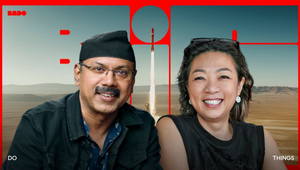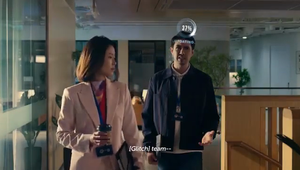
5 Minutes with… Guan Hin Tay

People who know Guan Hin Tay know he is a master of leveraging conflict to achieve innovation. As BBDO Singapore’s creative powerhouse, Guan Hin is committed to fostering creativity in advertising.
His first book, Collide: Embracing Conflict to Boost Creativity, was released this year, and quickly became a best-seller.
With over 20 years in the advertising industry, Guan Hin brings a wealth of experience and a fresh perspective on the role of conflict in driving creativity. Here, he explores the inspiration behind his book, draws on his rich career journey, and highlights pivotal moments that have shaped his approach to creativity.
LBB> Your recent book, 'Collide: Embracing Conflict to Boost Creativity,' explores the idea that conflict is essential for true advancement and collaboration. How did your experiences in the advertising industry contribute to this perspective, and what motivated you to share these insights in a book?
Guan Hin> I've been in the ad industry for over twenty years, and things have changed. It’s as if the young talent I see these days have lost the art of conceptual thinking. That's why I wrote this book – to shine a light on developing surprising, engaging, and creative ideas.
Getting my conceptual skills sharp and coming up with award-winners wasn't a walk in the park. It was all about trial and error. Take those times working on Unilever projects, where the clients would always ask: "Where's the tension?" And you know what? They had a point. The best ideas? They pop up from what I call 'creative conflict'.
This book is packed with illustrations and stories of "creative conflict". Some bits will hit you as brand new; others will feel like good old common sense. Each page and chapter is filled with stuff I use pretty often. We're talking real, hands-on strategies, not just fluffy theories.
My motivation for this book is to make creativity less of a mystery. There's this idea floating around that it's just for artsy folks, but I'm here to bust that myth. Creativity is for everyone, and trust me, anyone can get good at it.
LBB> Can you share a specific moment or project that you consider a highlight of your career and why?
Guan Hin> Two moments stand out to me, greatly impacting my journey.
First up is my time at the Art Center College of Design in Pasadena. This was a pivotal time for me. As a student from Singapore, diving into American culture was a whole new ball game. Studying in the Art Center was highly competitive, and everyone focused on their work. So imagine my surprise when, during the first Los Angeles Creative Competition, they announced my name for "Best of Show." I was stunned! There I was, surrounded by classmates bagging Golds, Silvers, and Bronzes, and then boom – my name gets called. It was surreal. Winning that award, along with a small trophy and $1,000 (a big deal for a student back then), was a massive confidence boost. It was a signal that I could make it in this challenging world.
In the late Nineties, I joined Saatchi and Saatchi Singapore when David Droga was the Regional ECD. Those two years were insanely intense but incredibly rewarding. The agency was a creative powerhouse. I was soaking up knowledge from amazing creatives like Francis Wee, Andy Clarke, Calvin Soh, Danny Higgins, Edmund Choe, Juggi Ramakrishnan, and many others. Their expertise in storytelling and conceptual skills was mind-blowing at that time.
LBB> Your role as creative chairman at BBDO Singapore involves delivering insightful creativity that builds on digital and innovative engagement. How do you balance your work's traditional creative approaches with emerging digital trends?
Guan Hin> Balancing traditional creative approaches with emerging digital trends is like being a chef in a fusion kitchen. You have classic recipes and time-tested techniques, but you're always curious about creating new flavours using the latest gadgets.
Let's start with the traditional side of things. In any creative work, the foundation is always understanding your audience. You've got to do your homework, dive into the data, and get a grip on what makes your audience tick. This is where we turn data into human insights. It's about crafting work that resonates, that feels authentic and relatable. And here's the thing: consumers still crave those compelling ideas no matter how digital our world gets. These big ideas? They need a few key ingredients.
First, there's an emotional connection. You know, it's often about something other than the gritty details of the product but how the communication makes you feel. That's what sticks with you. Then, there's the high recall factor. A unique creative concept can make your brand stand out in a sea of similar products. And, of course, there's narrative and storytelling. We all love a good story, right? It makes our creative work so much more engaging and memorable.
LBB> As the first Asian Cannes Lion Jury president for Outdoor, you've had a unique vantage point. How have you seen advertising and creativity change over the years, especially in the Asia Pacific region?
Guan Hin> The advertising landscape has transformed alarmingly, especially in Asia.
First, AI has a massive role. AI's not just some sci-fi concept anymore; it's used everywhere. We're using AI to write, create art, get to know our audiences, personalise their experiences, and crunch the numbers on campaign results. AI's speed and precision are game-changers in doing that. However, there is a danger that everything will eventually look or sound the same as this tool evolves. It's still about adding the human touch to our countless touchpoints.
Gone are the days of the one-size-fits-all message.
Now, it's all about creating content that truly engages. Whether long or short, the key is understanding various platforms and creating relevant content to fit the right audience. We're seeing more interactive and immersive experiences, storytelling that makes you feel something. It's not just about grabbing attention but making a human connection.
LBB> In addition to your role at BBDO Singapore, you're the president of Asia Professional Speakers Singapore. How does your public speaking and leadership involvement contribute to your creative work, and vice versa?
Guan Hin> Initially, I was quite poor at public speaking. Starting in this industry, I was trembling, nervous, and shy. Even pronouncing words correctly was challenging, and convincing clients to consider my campaigns was difficult.
A defining moment happened at Leo Burnett when I participated in a public speaking course. Upon hearing my presentation, the workshop leader offered unforgettable feedback. He emphasised that not eloquence matters but the passion conveyed in your speech. If you speak with strong passion and conviction, people will believe in what you say.
About five years ago, I committed to improving my speaking skills, both as a professional objective and a personal goal to gain confidence.
Joining Asia Professional Speakers Singapore was a step towards surrounding myself with professional speakers with similar aspirations. Beyond the creative community, finding the right tribe for conversation and an environment conducive to growth has significantly boosted my confidence on and off the stage.
LBB> With a career spanning JWT, Saatchi & Saatchi, Leo Burnett, and more, you've been part of several creative networks. How has working in diverse environments shaped your approach to creativity and problem-solving?
Guan Hin> My journey through the creative maze of advertising agencies - JWT, Saatchi & Saatchi, Leo Burnett, and now BBDO Singapore have been nothing short of a roller coaster, each twist and turn more exhilarating than the last.
Every agency's unique culture and methodologies have significantly contributed to my growth. It's like working in different offices worldwide, each with its distinct flavour.
It's about keeping an open mind, blending different styles and learnings to create something unique and compelling, and having fun with what you do. Because, at the end of the day, what's the point if you're not enjoying the creative process?
LBB> Your book discusses techniques for problem-solving and enhancing creativity. Could you share a practical tip or exercise that you find particularly effective in fostering creative thinking for yourself and the teams you work with?
Guan Hin> I'd love to share a bit from "Collide: Embracing Conflict to Boost Creativity." One of the core ideas in the book is about fostering creativity by colliding different concepts or ideas. It's like combining two familiar things to create something entirely new and unexpected.
This approach builds on what people already understand and relate to. Think about how advertisers use popular songs in commercials. They're tapping into something familiar to create a connection with the audience. It's the same with movies that blend different genres. They transport us to new worlds by mixing elements we're already familiar with but in a fresh and exciting way.
Combining familiar elements to create something new is a powerful way to engage people's curiosity and keep them returning for more. It makes a connection about more than just the product; it's about the experience and the surprise. I believe that's the essence of creativity – taking the known and "Colliding" it into something wonderfully unknown.















